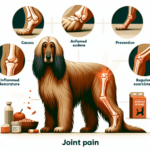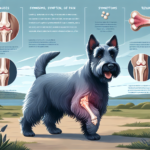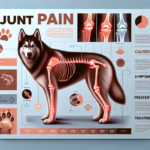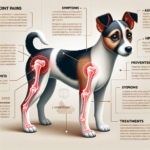Papillon Joint Pain: Causes, Symptoms, Prevention, and Treatment
Introduction
The Papillon, also known as the Continental Toy Spaniel, is a small, elegant breed known for its distinctive butterfly-like ears, from which it derives its name (“papillon” means “butterfly” in French). Originating in Europe, the breed has a rich history dating back several centuries, often depicted in paintings alongside European royalty. Papillons are characterized by their lively and friendly temperament, intelligence, and agility, making them excellent companions and competitors in dog sports.
While Papillons are generally healthy, they are not immune to certain health issues. Common concerns include dental problems, patellar luxation, and joint pain. Joint health is particularly crucial for Papillons due to their active nature and small size, which can make them more susceptible to joint-related issues.
Breed-Specific Joint Pain Risks
Genetic Predisposition
Papillons, like many other breeds, can be genetically predisposed to joint-related issues. One of the most common conditions is patellar luxation, where the kneecap dislocates from its normal position. This condition can lead to arthritis and other joint problems if not addressed. While hip dysplasia is less common in Papillons compared to larger breeds, it can still occur and contribute to joint pain.
Age-Related Risks
As Papillons age, the risk of developing joint pain increases. Degenerative joint diseases such as osteoarthritis can develop over time, leading to chronic pain and reduced mobility. Owners should be vigilant about changes in their dog’s behavior and physical abilities, especially as they approach middle age (around 7-9 years) and senior years (10+ years).
Activity Level and Joint Stress
Papillons are known for their high energy levels and agility. They excel in activities like agility training, obedience, and even flyball. However, their active lifestyle can put stress on their joints, especially if they engage in high-impact activities or repetitive motions. It’s essential to balance their exercise routine to prevent overexertion and joint strain.
Common Symptoms of Joint Pain in Papillons
General Symptoms
- Limping or favoring one leg
- Stiffness, especially after rest
- Reluctance to jump or climb stairs
- Decreased activity or playfulness
- Visible discomfort or pain when touched
Breed-Specific Symptoms
In Papillons, joint pain may manifest as a reluctance to engage in activities they once enjoyed, such as running or playing fetch. They may also show signs of discomfort when being picked up or handled, particularly around the hind legs.
When to Consult a Vet
If you notice any of the above symptoms persisting for more than a few days, it’s crucial to consult a veterinarian. Early diagnosis and intervention can significantly improve the quality of life for a Papillon suffering from joint pain.
Preventive Measures for Joint Health
Exercise Recommendations
Regular, moderate exercise is essential for maintaining joint health in Papillons. Activities like walking, swimming, and gentle play are excellent options. Avoid high-impact exercises that can strain the joints, such as excessive jumping or running on hard surfaces.
Dietary Suggestions
A balanced diet rich in essential nutrients can support joint health. Look for dog foods that contain glucosamine and chondroitin, which help maintain cartilage health. Omega-3 fatty acids, found in fish oil supplements, can also reduce inflammation and support joint function.
Weight Management
Maintaining a healthy weight is crucial for reducing joint stress. Overweight Papillons are at a higher risk of developing joint problems. Regularly monitor your dog’s weight and adjust their diet and exercise routine as needed to keep them at an optimal weight.
Early Screening and Monitoring
Regular veterinary check-ups are essential for early detection of joint issues. Your vet may recommend specific screening tests, such as X-rays or joint fluid analysis, to monitor your Papillon’s joint health. Early intervention can prevent minor issues from becoming severe problems.
Treatment Options for Joint Pain
Non-Surgical Treatments
For mild to moderate joint pain, non-surgical treatments can be highly effective. These may include:
- Medications: Nonsteroidal anti-inflammatory drugs (NSAIDs) can help reduce pain and inflammation.
- Physical Therapy: Exercises and stretches designed to improve joint mobility and strength.
- Lifestyle Adjustments: Modifying your dog’s activity level and environment to reduce joint stress.
Surgical Options
In severe cases, surgical intervention may be necessary. Common surgical options for joint pain in Papillons include:
- Patellar Luxation Surgery: Corrects the dislocation of the kneecap.
- Hip Dysplasia Surgery: Procedures like femoral head ostectomy (FHO) or total hip replacement (THR) can alleviate pain and improve mobility.
Alternative Therapies
Alternative treatments can complement traditional therapies and provide additional relief. These may include:
- Acupuncture: Can help reduce pain and improve joint function.
- Hydrotherapy: Water-based exercises that reduce joint stress while improving strength and mobility.
- Massage: Helps relieve muscle tension and improve circulation.
Lifestyle and Management Tips
Daily Care Routine
A consistent daily care routine can help manage joint pain in Papillons. This may include:
- Regular, gentle exercise to maintain mobility
- Administering prescribed medications or supplements
- Providing a balanced diet to support overall health
- Monitoring for any changes in behavior or mobility
Modifying the Home Environment
Making your home more comfortable for a Papillon with joint pain can significantly improve their quality of life. Consider the following modifications:
- Using ramps or steps to help them access furniture or beds
- Providing orthopedic beds for better joint support
- Ensuring food and water bowls are at a comfortable height
Long-Term Management
Long-term management of joint pain involves regular veterinary check-ups, ongoing monitoring, and adjustments to your dog’s care routine as needed. Keeping your Papillon active and engaged, while avoiding activities that strain their joints, is key to maintaining their quality of life.
FAQs About Papillons and Joint Pain
What are the early signs of joint pain in Papillons?
Early signs include limping, stiffness, reluctance to move, and decreased activity levels. If you notice any of these symptoms, consult your veterinarian for a thorough evaluation.
Can joint pain in Papillons be prevented?
While not all joint pain can be prevented, maintaining a healthy weight, providing a balanced diet, and ensuring regular, moderate exercise can significantly reduce the risk. Early screening and monitoring can also help catch issues before they become severe.
Are there specific exercises that are better for Papillons with joint pain?
Low-impact exercises like walking and swimming are excellent for Papillons with joint pain. Avoid high-impact activities that can strain the joints, such as jumping or running on hard surfaces.
What dietary supplements can help with joint health in Papillons?
Supplements containing glucosamine, chondroitin, and omega-3 fatty acids can support joint health. Always consult your veterinarian before adding any supplements to your dog’s diet.
When should I consider surgery for my Papillon’s joint pain?
Surgery is typically considered when non-surgical treatments are no longer effective, and the dog’s quality of life is significantly impacted. Your veterinarian can help determine the best course of action based on your dog’s specific condition.
Conclusion
Joint pain is a common concern for Papillons, but with proper care and attention, it can be managed effectively. By understanding the breed-specific risks, recognizing early symptoms, and taking preventive measures, you can help ensure your Papillon enjoys a healthy, active life. Regular veterinary check-ups and a tailored care routine are essential for maintaining joint health and overall well-being. Always consult your veterinarian for personalized advice and treatment options to keep your Papillon happy and pain-free.




